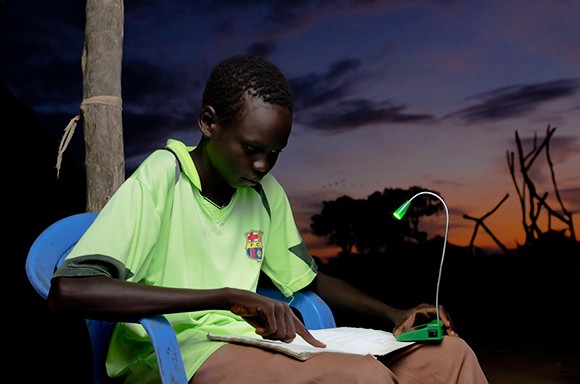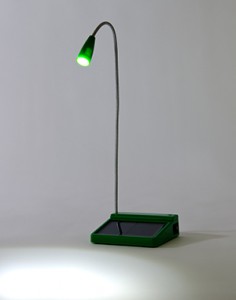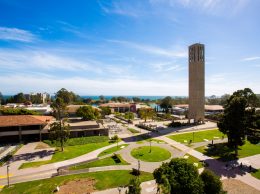Power is knowledge as Unite to Light devices spread around the world
IN THIS ARTICLE
- Green Coast Topic
- Marissa Wenzke Author
By Marissa Wenzke Friday, May 2nd, 2014

Goleta-based Unite to Light sells solar-powered lamps and cell-phone chargers that were designed at the Institute for Energy Efficiency at UC Santa Barbara. For each product the group sells, it donates one to a person in the developing world. (photo courtesy of Unite to Light)
A solar-powered LED light designed in the engineering labs of UC Santa Barbara has allowed thousands of schoolchildren in developing countries such as Ghana and Kenya to read at night, without electricity. Now, Goleta-based Unite to Light has developed a solar-powered cell-phone charger that lets people the world over power their phones with the sun.
Unite to Light’s two products have been distributed to more than 65 countries on four continents. For every one of its products sold, Unite to Light donates one to someone in the developing world.
Engineered in the Institute for Energy Efficiency at UCSB, the group’s first product was an all-purpose, solar-powered LED light that was designed as an alternative to environmentally destructive kerosene lamps. The portable light, called the UTL-1, retails for $20 in the U.S. The Goleta group is now offering a USB device charger that pairs with the solar-powered lamp. The combo retails for $60.
The idea for a solar-powered reading lamp came about when the president of Ghana Technology University College, Dr. Osei Darkwa, paid a visit to the IEE at UCSB in 2009.
John Bowers, director of the institute and a professor of electrical and computer engineering at UCSB, said he remembers Darkwa coming into the institute to ask about its research. “He wanted to know what we were doing with solar power…We had a real world-class effort in efficient LED lighting and in batteries and solar power,” Bowers said. “And I remember he said to me, very distinctly, ‘Why don’t you do something good for the world?’ ”
Darkwa told Bowers that more than 75 percent of Ghana’s population lacks electricity, with many university students from the northernmost region of the country — where there is the least electricity — struggling academically as a result. Darkwa suggested Bowers and his team create a very low-cost reading lamp that would be fueled by a renewable energy source like solar power, rather than harsh and limited fuels such as kerosene.
“The original intention was that the small light would replace kerosene, and the environmental impacts that kerosene has are pretty devastating,” said Dawn O’Bar, president of Unite to Light.
Open-flame kerosene lamps fill the households of more than 1.5 billion people worldwide, according to Unite to Light. Such fuels are expensive and they produce environmentally damaging soot and spoke. More importantly, their health risks to humans include lung damage and eye irritation. Bowers said using a traditional kerosene lamp for four hours in the evening is equivalent to smoking about two packs of cigarettes.
Kerosene is also very expensive, O’Bar said. “Economically, what we realized is that people were spending their income on this disposable kerosene fuel, and they could be buying lights that are recharged by the sun,” she said. “They could buy a lantern or solar light that could be used over and over again for several years.”
One donated for every one sold

The Unite to Light lamp retails for $60 in the U.S. but the Goleta-based group donates one to a community in a developing country for every one sold. (courtesy photo)
In November 2010, Unite to Light became a registered nonprofit. Similar to for-profit businesses like Tom’s Shoes, it sells its products in the U.S. and uses the proceeds to donate the lights to impoverished communities in countries including South Africa and Kenya.
Its new product, the UTL-C charger, works with devices such as smart phones and Kindle readers. Unite to Light said some of the groups its works with had been asking about an add-on product.
“Some of our partners said they wanted a light that was a little brighter and would also have the ability to charge cell phones,” O’Bar said. “We got together with our factory and our students and volunteers and said, ‘How can we design another unit that would be all-inclusive?’ ”
Unite to Light has teamed up with a San Francisco-based organization called World Reader to donate refurbished Kindles to schools in the developing world. So far, the organization has shipped Kindles with 100 books loaded onto each of them — including 50 books in English and 50 in the native language Swahili — to a school near Kenya’s capital, Nairobi.
Unite to Light’s charger also has plenty of use in the developed world. Daniel Fishbein, a volunteer involved with the development of the UTL-C, said he uses it regularly since it can be carried anywhere. “If you’re bicycling or hiking and you’re in a remote area, you might not have anywhere else to charge your phone,” he said. American users can also use the portable lamps during outdoors activities such as camping or for emergency kits, O’Bar said.
‘Need to send millions’
Michael Holland, a technical consultant at the Ventura-based company Holland Electronics, was also involved with product development at Unite to Light on a volunteer basis. The group is constantly refining its technology to make the product ever-more cost-effective and efficient, he said. “As the technology and the pricing of batteries drops, the products that use them have to change,” Holland said. “As we see a new technologies come up, we have to try to incorporate them and get the product cheaper.”
Bowers said the small lights can have a huge impact. One school in Ghana saw a 30 percent increase in test scores after receiving 100 lamps from Unite to Light, he said, underscoring the potential impact of the project if it can be scaled. “It really is a moral imperative that we get this into children’s hands,” Bowers said. “We’ve sent 68,000 so far, but we need to send millions.”










